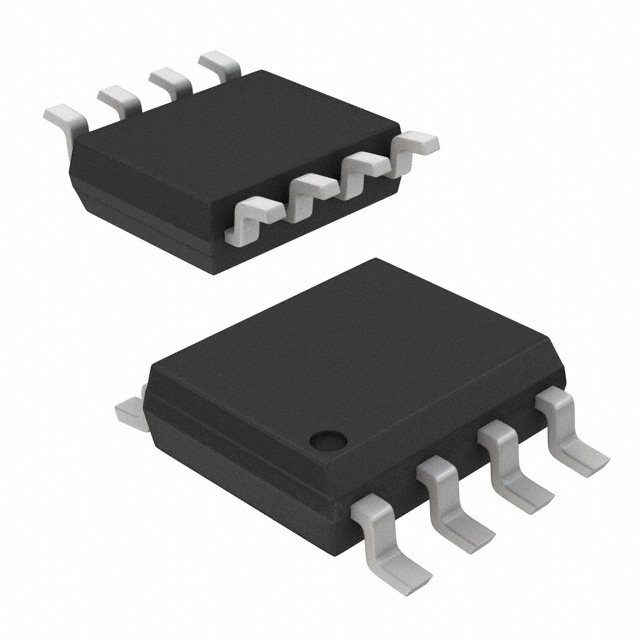KA555ID
Product Overview
Category: Integrated Circuit (IC)
Use: The KA555ID is a versatile timer IC that can be used in various applications such as timing, oscillation, and pulse generation.
Characteristics: - Low power consumption - Wide operating voltage range - High stability and accuracy - Easy to use and configure
Package: The KA555ID is available in an 8-pin DIP (Dual Inline Package) format.
Essence: The essence of the KA555ID lies in its ability to provide precise timing functions in electronic circuits.
Packaging/Quantity: The KA555ID is typically sold in reels or tubes containing a quantity of 250 or 1000 units.
Specifications
The KA555ID has the following specifications:
- Supply Voltage Range: 4.5V to 16V
- Operating Temperature Range: -40°C to +85°C
- Timing Capacitance Range: 100pF to 100μF
- Timing Resistance Range: 1kΩ to 100kΩ
- Output Current: 200mA (maximum)
- Trigger Voltage: 1/3 Vcc
- Reset Voltage: 0.7Vcc
Detailed Pin Configuration
The KA555ID has 8 pins arranged as follows:
- GND (Ground): Connected to the ground reference of the circuit.
- TRIG (Trigger): Used to initiate the timing cycle.
- OUT (Output): Provides the output signal based on the timing configuration.
- RESET (Reset): Resets the timing cycle when triggered.
- CTRL (Control Voltage): Allows external control of the timing cycle.
- THR (Threshold): Determines the upper threshold for the timing cycle.
- DIS (Discharge): Discharges the timing capacitor during the timing cycle.
- VCC (Supply Voltage): Connected to the positive supply voltage of the circuit.
Functional Features
The KA555ID offers the following functional features:
- Monostable Mode: Generates a single pulse of a specified duration.
- Astable Mode: Produces a continuous oscillating waveform.
- Bistable Mode: Functions as a flip-flop, maintaining its state until triggered.
- Adjustable Timing: The timing cycle can be easily adjusted using external resistors and capacitors.
- Wide Range of Applications: Suitable for various applications including timers, frequency generators, and PWM (Pulse Width Modulation) circuits.
Advantages and Disadvantages
Advantages: - Versatile and widely used in electronic circuits. - Low power consumption makes it suitable for battery-powered devices. - Simple to use and configure. - High stability and accuracy ensure reliable timing functions.
Disadvantages: - Limited output current may not be sufficient for certain applications. - Requires external components (resistors and capacitors) for timing configuration.
Working Principles
The KA555ID operates based on the principles of an internal comparator, flip-flops, and a discharge transistor. It uses an RC network (resistor-capacitor) to control the timing cycle. When triggered, the internal flip-flops change state, which affects the output signal and initiates the timing cycle. The timing capacitor charges or discharges through the timing resistor, determining the duration of the timing cycle.
Detailed Application Field Plans
The KA555ID finds extensive application in various fields, including:
- Timing Circuits: Used in applications requiring precise timing, such as clocks, timers, and delay circuits.
- Oscillators: Employed to generate square wave signals for frequency generation and clock synchronization.
- Pulse Width Modulation (PWM): Utilized to control the width of pulses in applications like motor speed control and LED dimming.
- Frequency Dividers: Used to divide input frequencies for frequency scaling and synchronization purposes.
- Tone Generation: Applied in audio circuits for generating tones, alarms, and musical notes.
Detailed and Complete Alternative Models
Some alternative models to the KA555ID include:
- NE555: A popular timer IC with similar functionality and pin configuration.
- LM555: Another widely used timer IC offering enhanced performance and additional features.
- TLC555: A low-power version of the 555 timer IC, suitable for battery-powered applications.
- LMC555: A CMOS version of the 555 timer IC, providing improved power efficiency and noise immunity.
These alternative models offer similar functionality and can be used as substitutes for the KA555ID depending on specific requirements.
Word count: 615 words
Senaraikan 10 soalan dan jawapan biasa yang berkaitan dengan aplikasi KA555ID dalam penyelesaian teknikal
Sure! Here are 10 common questions and answers related to the application of KA555ID in technical solutions:
Q: What is KA555ID? A: KA555ID is a popular integrated circuit (IC) timer that can be used in various technical applications.
Q: What are the main features of KA555ID? A: KA555ID features a stable timing capability, adjustable timing range, low power consumption, and compatibility with a wide range of voltages.
Q: How does KA555ID work? A: KA555ID operates as a timer by utilizing an internal oscillator and comparators to generate precise timing signals.
Q: What are some common applications of KA555ID? A: KA555ID is commonly used in applications such as pulse generation, frequency division, time delay circuits, LED flashers, and tone generation.
Q: Can KA555ID be used as a voltage-controlled oscillator (VCO)? A: Yes, KA555ID can be configured as a VCO by using external components to control the timing frequency.
Q: What is the maximum operating voltage for KA555ID? A: The maximum operating voltage for KA555ID is typically around 18 volts.
Q: Can KA555ID operate at low voltages? A: Yes, KA555ID can operate at lower voltages by using appropriate voltage regulators or level shifters.
Q: How accurate is the timing of KA555ID? A: The timing accuracy of KA555ID depends on various factors, but it is generally considered to be quite precise for most applications.
Q: Can KA555ID be used in battery-powered devices? A: Yes, KA555ID's low power consumption makes it suitable for use in battery-powered devices.
Q: Are there any common troubleshooting tips for using KA555ID? A: Some common troubleshooting tips include checking the connections, ensuring proper power supply, and verifying the component values used with KA555ID.
Please note that these questions and answers are general in nature and may vary depending on specific applications and requirements.


